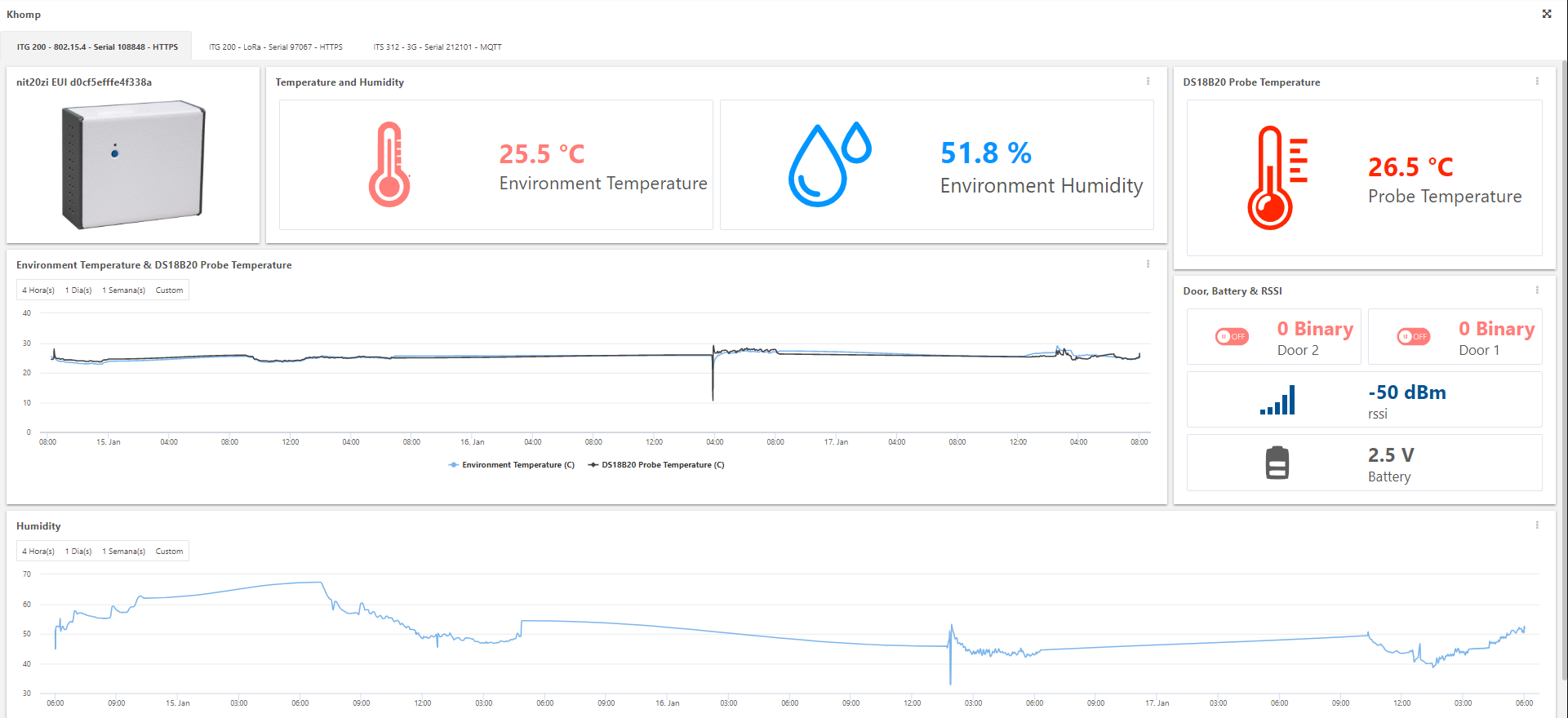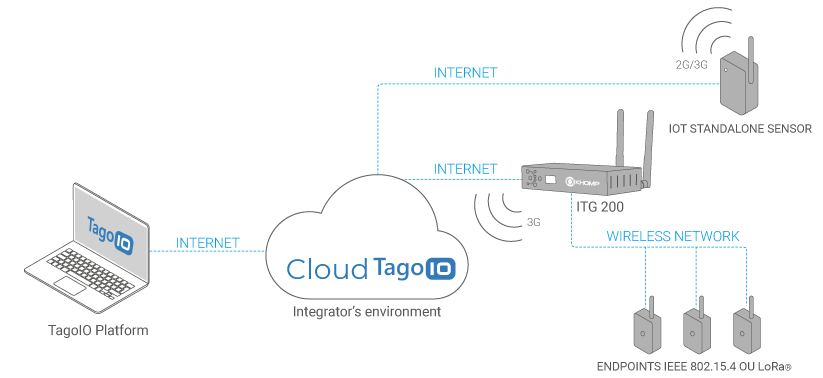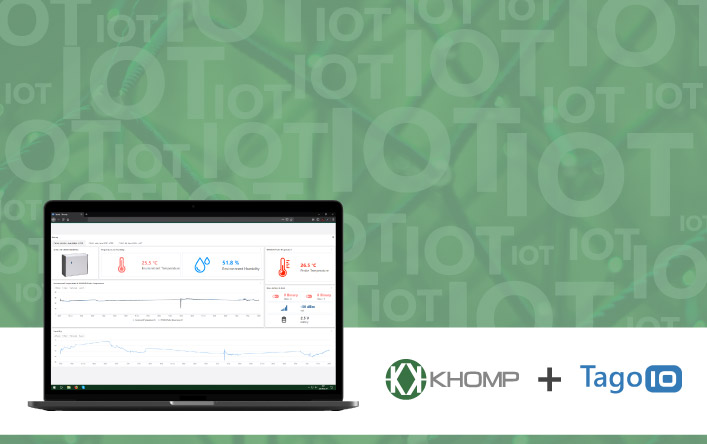With the intention of developing an IoT monitoring solution, Khomp has entered into a partnership with Tago, the developer of the TagoIO platform, the first tool endorsed for use with the products of the IoT line from Khomp.
What is the TagoIO platform?
TagoIO is a 100% cloud-based web platform for high level monitoring of environments via IoT devices connected to your network. According to its CEO, Fábio Rosa, Tago currently has two advantages: the speed at which an IoT solution can be implemented in the market, and the fact that it is a powerful tool that offers a wide range of functions that are necessary for such implementation.
With this platform, the user can observe the data collected in a practical dashboard for building his or her applications. With its simple and dynamic panel, it is possible to share and track the use of the application, as well as create levels of access for different users, defining what each one may see and edit.
Created by Tago, the platform is recommended for anyone who needs a quick solution that is simple to configure and can quickly be ready to get your monitoring system running.
How does the TagoIO platform work?
The TagoIO platform makes it possible for companies to quickly create and develop an IoT solution. These types of applications can be found in a wide variety of segments, such as: industrial automation, intelligent irrigation, internal location of deposits, composition, refrigeration and telematics.
The process for developing an IoT solution has four steps. The first involves the connection of a device through Wi-Fi, LoRa, Sigfox, GPRS, LTE, BLE, or ZigBee, among others, that can perform readings of an environment and send the data to the platform. Then it is necessary to choose a template to begin the construction of the application and integrate the solutions by entering the data from external systems. To finalize the process, it is necessary to create and manage the users and devices, quickly scaling the application.
After this configuration, the system dashboard is ready for monitoring.
The user can create a variety of panels using resources for mapping and markers, as well as add links, images, formulas, graphics, videos and other widgets that fit the solution, in real time.
“With TagoIO, companies in the Brazilian market no longer need to build a complex infrastructure base. The platform makes it possible to integrate equipment quickly so that you can focus on implementation of an IoT solution,” states Rosa.

Dashboard of the TagoIO cloud platform for monitoring humidity and temperature with a Khomp IoT Endpoint and Gateway.
Khomp equipment for IoT solutions
Khomp provides a complete portfolio of IoT devices which are capable of reading data from the environment and sending such data to be monitored by the TagoIO platform. Check it out:
EndPoints
Equipment that collects data at the location to be monitored. There are two models, the IEEE 802.15.4 Endpoint and the LoRa® Endpoint. The first supports IEEE 802.15.4 radio, ideal for applications at short or medium distances, such as at companies.
The second Endpoint supports LoRa radio, ideal for external applications over long distances. These include, for example, public networks, universities or intelligent cities.
Gateway ITG 200
The ITG 200 gateway is responsible for transmitting all data received from multiple Endpoints (as many as needed) to the server, which may be in a local network or in a cloud, such as the TagoIO platform.
Get to know the main features of the ITG 200, its advantages and applications!
IoT Standalone Sensor
Designed for applications in locations that are isolated or far from an Internet network, the IoT Standalone Sensor (ITS) makes the use of a gateway unnecessary because it performs both the collection and transmission of data directly to a cloud via a Mobile network.
“Tago has realized how hard it is to find devices ready for IoT solutions in Brazil, and they believe this is one of the main obstacles preventing Brazil from evolving in this field. Khomp has designed equipment, manufactured in Brazil, that enables our clients to implement an IoT ecosystem, in addition to offering all of our support. The partnership between Tago and Khomp establishes a strong reference and increases confidence in the Brazilian market,” emphasizes Rosa.

Image caption: In this type of application, the Khomp IoT devices were configured to point directly to the TagoIO cloud solution.
Main functions of the TagoIO platform
With the dashboard configured and equipment installed, the user has access to the wide range of functions TagoIO offers for planning and personalizing an IoT solution.
The first of these is the configuration of IoT devices. To add them to the application, a token is generated that will create the connection and authentication of the equipment.
Another essential function is the configuration of a data bank made available by Tago for the application. With the data bank, the user can easily manage and store all of the application’s data. The visualization and management of each variable stored is easily handled in the data bank and, for this reason, it is unnecessary to learn a specific programming language for managing the data.
The following functions are used for analysis and automation of flow. Developers can implement scripts to handle data from any device in real time, making this a powerful resource for adding more value to an IoT solution. Using this process, it is possible to make simple calculations, create reports and even implement machine learning.
Another important function of TagoIO is its capacity to synchronize events and execute actions. The user can send SMS, emails, notifications or execute actions employing analytical scripts that have their own rules. This way, the platform combines the functions of actions and analysis, making it possible to create conditions for events, as well as add if/else functions.
When the solutions are being prepared to become active, the functions of find and install applications will be responsible for assisting the process. Users and developers can use demos that have already been created in the platform for a wide range of applications. What makes it easy is the ability to perform an operation with just a few clicks and make a demonstration available for all of the members of your team.
Would you like to know more?
To find out more about all of the features of the TagoIO tool, access the platform site here.
Subscribe to the Khomp newsletter to receive other articles on technologies that can help with the evolution of your IoT solution.
